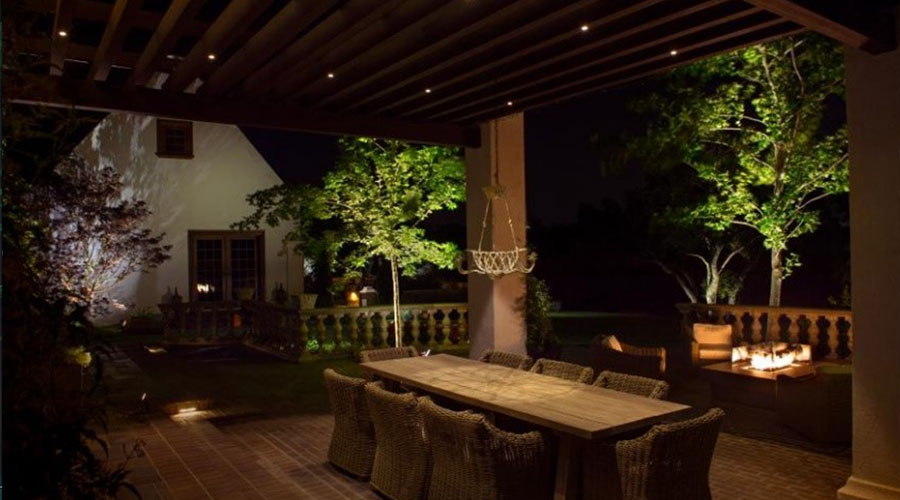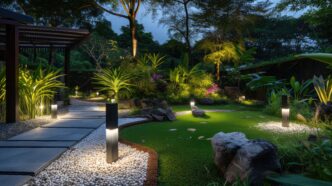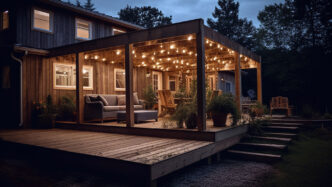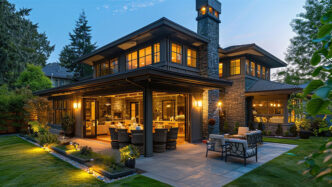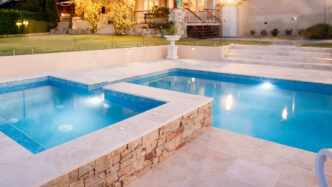One of the many joys of having a backyard is not just having a garden but also having a place to prepare meals using the very vegetables that you grew over the season.
Whether it’s a casual family barbecue, a romantic dinner under the stars, or an evening with friends, the right landscape lighting can transform your outdoor eating area into a magical, inviting space. Beyond just extending the usability of your outdoor spaces after dark, well-designed landscape lighting adds a layer of ambiance, enhances safety, and improves the overall look and feel of your home.
In this guide, we’ll explore how to use landscape lighting to create the perfect outdoor dining experience, from choosing the right fixtures to planning the layout, plus creative lighting techniques to make every meal feel like a special occasion.
The Importance of Lighting in Outdoor Dining Spaces
Outdoor dining is as much about atmosphere as it is about food. And in this way, lighting serves several key purposes:
- Ambiance: The soft glow of lighting can set the mood for a warm and welcoming atmosphere, making your outdoor space feel cozy and intimate.
- Functionality: Proper illumination ensures that you can see what you’re eating and that your guests can move around safely.
- Aesthetics: Lighting can highlight the best features of your garden, patio, or deck, enhancing the overall beauty of your outdoor dining area and stunning landscape.
Choosing the Right Type of Landscape Lighting
There are various types of landscape lighting fixtures, each serving different purposes. Selecting the right mix is crucial for achieving a balanced and appealing look.
- Professional-Grade String Lights: Also known as bistro lights or fairy lights, these are perfect for adding a touch of whimsy to your dining space. Professional-grade string lights are versatile, easy to install, and can be strung across patios, decks, or pergolas to create an enveloping canopy of light.
- Pathway Lights: A key part of properly illuminating walkways, pathway lights guide your guests safely to and from your dining area. These lights also add a decorative element, framing your outdoor space and highlighting landscape features.
- Spotlights and Uplights: Use spotlights and uplights to highlight specific elements such as trees, statues, or architectural features. They can create dramatic effects and add depth to the composition of your garden by casting sinewy shadows and sprawling textures.
Planning the Lighting Layout for Your Outdoor Eatery
The key to effective landscape lighting is a well-thought-out plan that considers both function and fashion. Here are some steps to help you design the perfect layout for your outdoor dining area:
- Assess Your Space: Start by observing your outdoor dining area at night. Identify dark spots, focal points, and the areas where you and your guests will spend the most time.
- Define Zones: Divide your space into zones such as dining, cooking, and lounging areas. Each zone will have different lighting needs; for example, the dining area requires soft, ambient lighting, while the cooking area needs brighter, task-oriented lights.
- Layer Your Lighting: Just like indoor lighting, outdoor lighting should be layered to create depth and interest. Combine ambient, task, and accent lighting to achieve a balanced look.
- Consider Control Options: Incorporate dimmers, timers, and smart controls to adjust the lighting based on the time of day or the mood you want to create. Smart lighting systems allow you to control your lights remotely, schedule them to turn on or off, and even change the color of the lights.
- Plan for Power Sources: Ensure you have adequate power sources for all of your fixtures. Solar-powered lights are a great option for areas without easy access to electrical outlets, while low-voltage systems are energy-efficient and easy to install.
Creative Lighting Techniques for Outdoor Dining
Now that you have a basic understanding of the types of lighting and how to plan your layout, it’s time to get creative. Here are some ideas to inspire your outdoor lighting design:
- Moonlighting: Moonlighting involves placing lights high in trees or on tall structures to mimic the natural light of the moon. The end result is soft and enchanting, perfect for creating a romantic atmosphere.
- Shadow Play: Use spotlights or uplights to cast shadows and silhouettes of plants, sculptures, or architectural elements onto walls or fences. This adds an added layer of eye-catching goodness and can make your space feel larger.
- Colorful Lighting: While warm white light is classic and versatile, don’t be afraid to experiment with colored lights. RGB lights give you the depth of subtle blues and greens to add a cool, calming effect, while reds and oranges create a warm, festive vibe.
- Fire Features: If you have a fire pit or outdoor fireplace, use it as a focal point and take it to the next level with lower-level lighting. The natural light from the fire adds warmth and ambiance, making it an ideal centerpiece for gatherings.
Safety Considerations for Your Outdoor Dining Area
While aesthetics and ambiance are important, you should never overlook safety. Here are some tips to ensure your outdoor lighting is safe and functional:
- Avoid Glare: Position lights to avoid shining directly into you or your guests’ eyes. Use diffusers or frosted glass to soften harsh light.
- Strategic Path Lighting: When you’re illuminating your pathways, line the lights along just one side of the path rather than both. This reduces the risk of tripping over fixtures while still providing enough effective illumination for safety. For stepping stone walkways, well lights integrated into the stones provide the safest option because they are buried and less likely to cause a tripping hazard.
- Weatherproofing: Make sure that all of your outdoor lighting fixtures are rated for outdoor use and can withstand the elements. Look for fixtures with a high IP rating, which indicates protection against water and dust.
- Cable Management: Keep your cables and wires organized and secure to prevent any tripping hazards. Bury the cables underground where possible or use cable covers to keep them out of sight.
- Regular Maintenance: Regularly check your lighting fixtures for wear and tear, and replace any damaged bulbs or cables. Clean lenses and shades to ensure the light output remains bright and even.
Outdoor Dining Done Right: Bringing It All Together with Landscape Lighting
Creating a well-lit outdoor dining area involves more than just installing a few lights—it’s about designing an experience.
By carefully selecting your lighting fixtures, planning your layout, and incorporating creative techniques, you can transform your outdoor eatery into a beautiful, functional, and inviting area where you’ll love spending time, day or night.
Whether you’re hosting a dinner party, enjoying a quiet evening meal, or simply relaxing under the stars, the right landscape lighting will make your outdoor dining experience truly unforgettable. So, light up your nights and let your outdoor space shine!
Want to light up your inbox? Join our Insider list and check out the different landscape lighting options that we have to offer.

